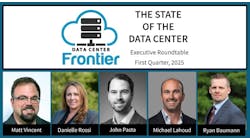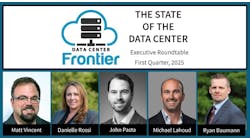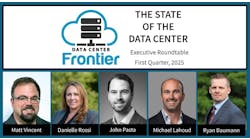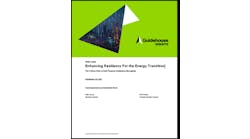The Data Center Frontier Executive Roundtable features insights from industry executives with lengthy experience in the data center industry. Here’s a look at the insights from Chris Downie of Flexential.
Before Flexential, Chris was Chief Executive Officer at Telx Holdings, a leading interconnection and data center solutions provider based in New York City. He has more than 30 years of executive leadership experience in finance and operations, working for Bear Stearns, Daniels & Associates, BroadStreet Communications and Motient Corporation.
Chris holds a bachelor’s degree in History from Dartmouth College and a master’s degree in International Business from New York University.
Here’s the full text of Chris Downie's insights from our Executive Roundtable:
Data Center Frontier: The arrival of generative AI technologies, popularized by ChatGPT, has the potential to disrupt search and other leading Internet businesses. How might the huge interest in generative AI bring changes in data center hardware and design?
Chris Downie, Flexential: From answering customer service inquiries to creating legal documents, ChatGPT has already proven to be a transformative solution across industries. Since its inception, our hyperscale customers have been seeking environments that support these capabilities; to adhere to this need, we’ve taken proactive steps to offer AI-optimized data center infrastructures.
For instance, we’re driving up power densities in our core facilities to support on average 10-12kW per rack for new workloads, with some AI workloads requiring well over 40kW per rack. We’re modifying our physical environments to support variables, such as increasing cabinet heights and trialing new liquid cooling techniques.
At Flexential, we work with customers to ensure they get what they need today and as their needs grow. As major tech companies accelerate AI rollouts, applications will require more computing capacity and in turn, clients' connectivity needs are evolving.
Given this, Flexential is continuously rolling out new interconnection solutions. Most recently, we announced an enhancement for Flexential cloud customers with the enablement of three additional data centers in Charlotte, Nashville, and Louisville. This expansion empowers Flexential cloud customers with a superior user experience, enhanced network performance and the ability to extend applications and workloads beyond on-premise data centers. In 2023, we’re going to continue to look for ways to empower customers' IT journey, helping them prepare for - and succeed in - the AI-driven future.
Data Center Frontier: After years of trending lower, pricing for data center capacity increased in 2022. What lies ahead for data center pricing, and what are the primary factors that will influence where prices go in the future?
Chris Downie, Flexential: Trends and changes in motion pre-pandemic have only accelerated in recent years. Now more than ever, data centers are mission-critical as services for healthcare and education and enterprises are hyper-reliant on connectivity. Increased demand, lasting effects of the pandemic and recent geopolitical challenges have made data center equipment scarce and in turn, more expensive. Construction companies, as well as cloud and technology providers are raising prices and as a result our industry has had to react to these shifts.
We’re also seeing a growing constraint on Tier 1 markets where prices have risen due to increasing demand for space and power. On the upside, secondary markets continue to offer very attractive options for customers who are willing to leverage these locations for their future buildouts.
Flexential has been ahead of this trend given 70% of our capacity is delivered in secondary markets, positioned near the 30 fastest-growing U.S. cities. Also, Flexential’s focus on sustainability is part of our long-term solution to ease pricing. Our next-generation designs drive efficiency throughout our operations, enabling highly cost-effective implementations.
Data Center Frontier: In early 2023 we’ve seen several announcements of plans for hydrogen-powered data centers. What are the potential benefits and barriers to the use of hydrogen in data center power?
Chris Downie, Flexential: Space research and development has pioneered many new technologies over the last century, and hydrogen-power is no exception. The space industry is now also driving the use of water as a future fuel source, which can be split to produce hydrogen for future Moon and Mars missions. It’s one reason why the federal government has produced a "path to hydrogen" framework.
For data center providers, there’s an opportunity for us to use new technologies like hydrogen to deliver renewable energy capabilities. However, we must enable a reliable supply-chain to use hydrogen on a large scale. A potential solution involves swapping fuel sources (such as natural gas used to power cells) with hydrogen as the capability to reliably deliver hydrogen comes on stream. Today it can be deployed in a small footprint, container-sized form-factor that could provide 1-2MW. The byproduct is steam at 120 degrees C. In conjunction with an absorption chiller, the energy from the steam can be used to provide for cooling for data centers.
At Flexential, our operations teams are working to evaluate many of these new fuel sources as we diversify our capabilities for the future as part of our commitment to an energy-efficient future. Our gen 5 designs already deliver PUEs of 1.4 or under and zero water usage, with the goal to drive this down further in future iterations. That’s why we have committed as part of our recent 1.2B ABS green financing initiative to direct funding for future builds and retrofit projects to be aimed at leveraging advances in sustainability.
Data Center Frontier: As campuses get larger and some primary markets experience constraints on land or power, what are the characteristics that will define growth markets in the next several years?
Chris Downie, Flexential: From Northern Virginia to Silicon Valley, space and power challenges are particularly acute in primary data center markets given available land, data center space and power are already in short supply. On top of this already crowded market, ongoing supply chain disruptions and geopolitical challenges are causing many high-tech companies to bring their research and development (R&D) and manufacturing operations back to the States, pushing tier 1 markets to their tipping point. The increased demand for data center space and power has caused a keen focus (and need) on tier 2 markets for future expansion plans, like Hillsboro, OR.
Hillsboro delivers a prime geographic gateway to cultivate business relationships with Asia Pacific counterparts, as well offering attractive business tax incentives, tax credits and abatement programs. Flexential is one of the first industry leaders to establish a presence in Hillsboro's fast-growing market and recently expanded its footprint with Hillsboro 4 in September 2022. As the long-standing home of the New Cross Pacific and Hawaiki subsea cables and offering access to three other subsea cables in the market, the Hillsboro 2 data center has established a reputation as the most connected data center in Oregon. In 2023 and beyond, we’ll see more companies shift their focus to tier 2 markets.







